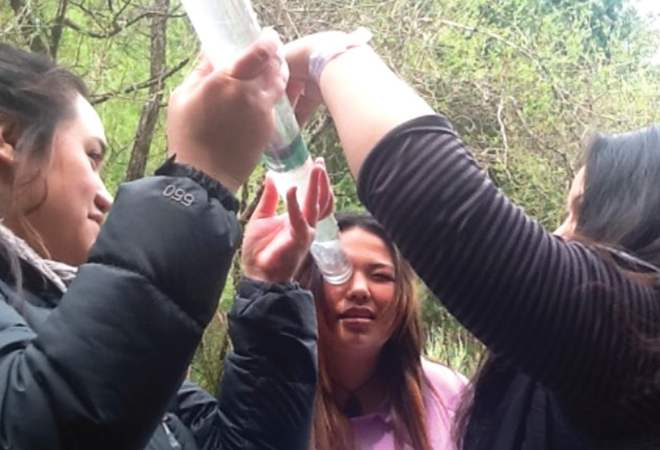
Project-based learning focused on numeracy and literacy skills with Māori second-chance learners
Status
Completed: 30 November 2015
Project Details
A project completed in 2015, undertaken by Matapuna Training Centre, to create two integrated Project-based Learning (PBL) experiences, which included a strong numeracy and literacy focus, that would engage Māori second-chance learners.
Aims:
The key aims of the project were to:
- create two integrated student work projects, with accompanying teaching and learning material, that target and empower disengaged Māori youth with high numeracy and literacy needs
- encourage the key competencies of thinking, acting autonomously, using tools interactively and operating in social groups
- design the projects in a way that they could be easily shared or replicated by other organisations.
Methodology:
The development of the two PBL projects involved 5 integrated stages or cogs of planning and implementation: choosing the topics, identifying units that fall out of the topic and including them on the integrated unit planning sheet, a pre-teaching phase, an activity phase, and a post-work phase.
Team

Anwyl Minnaar
Matapuna Training Centre
Peter Howarth-Jarratt
Matapuna Training CentreStatus
Funding
$22,575.00 (excl GST)
Key Findings
Evidence that the projects benefited learners are shown in the following findings:
- Gain reports in numeracy and literacy surpassed the centre-wide results with an average gain in numeracy of 37.5 with 32% making significant gains and an average gain in literacy of 17.8 with 11% making significant gains.
- Learners achieved success in a range of numeracy and literacy unit standards.
- Learners gained skills related to using scientific equipment including PH tests, conductivity, water clarity, compass use, and magnifying glass tasks.
- Learners really enjoyed their project work – very positive feedback from students and staff clearly indicated that students were engaging better around the Centre. Many felt it was due to the group work and the positive experiences they had shared together.
- Learners made vocabulary gains – the active learning also led to discussions using the correct scientific terms that were at least Level 2 standard and some Level 3.
Key Recommendations
Make the learning relevant to the learner | There was a clear intention to make the content of interest to the learners. The first project was the easier to choose as waka have a strong presence in Māori culture. The second project took a slightly greater ‘risk’ by exposing students to new experiences. Feedback from the Waka Project showed that the students enjoyed the tactile experience, so this was combined with learning new things as the students became ‘scientists’ in the Stream Project.
Focus on your goals when designing the project content | Although the projects needed to be relevant and engaging, they also needed to meet the qualification requirements. The literacy and numeracy (LN) standards have the benefit of being flexible in delivery but they also have strict requirements. These requirements had to be embedded into the project content and activities. Developing Project Based Learning (PBL) and embedding learning outcomes required imagination, flexibility and a sense that everything cannot be planned. A major goal was to have built in freedom; freedom to adapt and change depending on the situation.
Include practical activities and group work to engage students | It was evident from prior work that Māori students were more inclined to work as a group, which really suits the PBL style. Using L&N units, which every student requires in some way, also supports the group work strategy. From the outset, the tutors knew there would be challenges with group work as the students lacked the necessary communication skills that group work requires. This was tackled by spending two weeks concentrating on verbal and non-verbal communication and reinforcing this around the Centre at break times.
Celebrate student success | Feedback from students indicated that this was the first time they had actively engaged in an ‘education’ group activity since primary school. There were obviously many reasons that contributed to this feedback that were out of the scope of the report but the Centre made a point of celebrating this successful engagement through a variety of ways including: personalised certificates, special lunches, and informal encouraging comments from staff out of class.
Include Māori perspectives and tikanga | A trip to the museum focused on atua and the role they play in nature. Other concepts explored included Māori perspectives on sustainability and conservation. These included biotic and abiotic factors, food webs, water cycles, habitats and traditional Māori food sources.
Include Māori pedagogy | The concept of tuākana and tēina were incorporated in the teaching, with students acting as group leaders and tutors. The teaching included practical group work in which the students had the opportunity to act as leaders and each member had a role to play. The philosophy of ako was shown by tutors and students learning together through the discovery process and enquiry learning. It was an activity project which focused largely on whakarongo (listening), kōrero (speaking) and titiro (looking).
A report prepared by Anwyl Minnaar and Peter Howarth-Jarratt.
(PDF, 1.22 MB, 11-pages).
- 30 November 2015
A resource prepared by Anwyl Minnaar and Peter Howarth-Jarratt.
(PDF, 8 MB, 58-pages).
- 30 November 2015